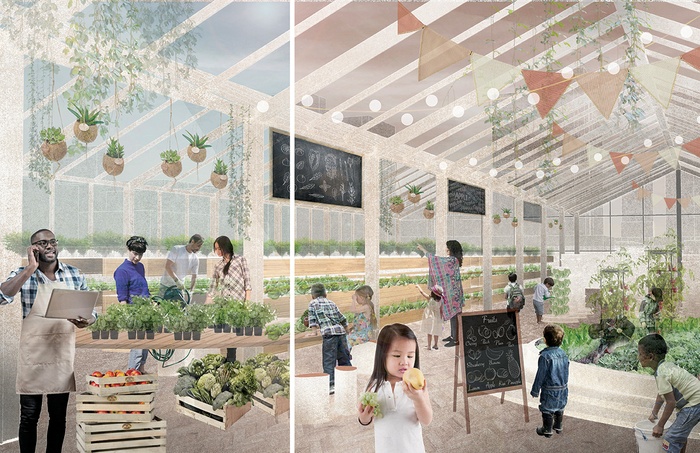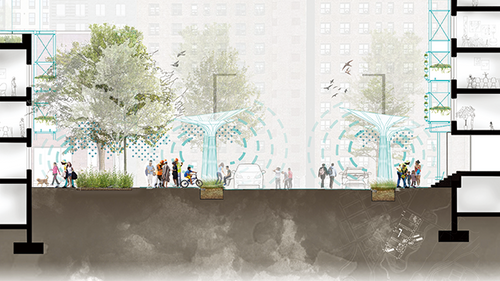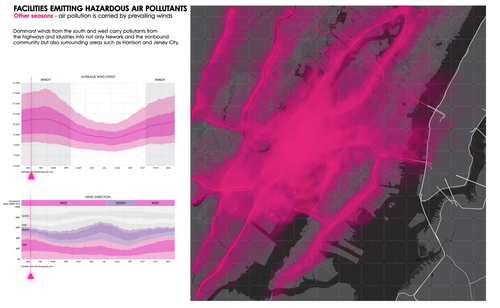Introduction
Urban Design
The Urban Design program engages the complex processes of global urbanization amid the emerging stress of the climate crisis. Ways of living in cities and landscapes around the world are increasingly untenable, and now require new forms of research and attention. What is the agency of design in these rapidly shifting conditions? The program frames the city not as a fixed, delineated territory but instead as a gradient of landscapes supported by networks of energy, resources, culture, mobility, and capital. It addresses near and long term threats to local, regional, and global ecosystems, positioning design as both an inclusive, activist, tools-based project for specific sites and communities, and as a critical project examining urban form, process, and knowledge. The following presentation of work from the 2020-2021 first two semesters illustrates the critical and creative ambitions that students brought to a variety of New York City sites and to a National audience for Green New Deal policy and practice. Students bring a multi-scalar analysis of urban-regional fabrics and infrastructures together with on-the ground interactions, communities engagements, and local conditions.
Urban Design Studio I
Harlem River & Three Bridges
Nans Voron (Coordinator)
Tami Banh, Noah Chasin, Ifeoma Ebo, Sagi Golan, Austin Sakong
The Fall Semester Studio is an immersive and intensive city-making laboratory where students develop tools for designing resilient, equitable, vibrant, and healthy environments within the New York City Metropolitan Area. During this first studio of the program, the curriculum is focused on the scale of the neighborhood. Here the neighborhood is explored as both a social construct and as a physical territory, both central to popular, journalistic, political, and design discourses. Working in today’s postindustrial, socially inequitable, and climate-stressed conditions, the students are asked to critically interrogate and redefine the many layers of existing urban fabrics and infrastructures to address the challenges faced by current and future inhabitants. This year, the Fall Studio focuses on two sites, one at the southern tip of Manhattan (three bridges), the other at the northern tip (Harlem River) – each a neighborhood undergoing change and challenge.
Students: Chinedu Obinna Adiele, Ahmed Abdullah Al Yaseen, Aruna Ananta Das, Anirudh Venkat Bodempudi, Yiyang Cai, Lingbei Chen, Lonas Long Yin Chiu, Yuehui Du, Corina Fuenmayor Herrero, Ishita Ghosh, Kai Guo, You Jin Hwang, Zuzanna Z Jarzynska, Chrysothemi Kouloumentas, Cheng Ju Lee, Yoo Jin Lee, Chao Li, Wenjuan Li, Chen Liu, Luchen Liu, Victor Yuan-Ting Lo, Yifei Luo, Mariana Kazumi Majima Ueda, Wenyi Peng, Thanawat Phituksithkasem, Nupur RoyChaudhury, Kyle Wilson Sam, Jil Shah, Yi Shang, Yuhui Si, Xiaofei Sun, Yuqi Tian, Scarlet Nga Chin Tong, Xindi Wang, Yunpeng Wu, Dhania Yasmin, Zheng Yin, Lijing Yu, Kai Zhang, Rui Zhang, Wanjing Zhang, Huiya Zhong, Yong Zhuang

Public Food integrates urban agriculture and food consumption with public schools in the Lower East Side. This enables the enhancement of existing infrastructure without the need for additional land. Furthermore, it can also educate future generations about the benefits of healthy living, raise awareness on food insecurity, and explore the possibilities of growing fresh food locally.

Located between the Lower East Side, Chinatown, and the Financial District, this project proposes an agora at the heart of NYCHA Alfred E. Smith Houses to complement the existing repository and legacy of social and political activism in the community. It serves as an incubator space and public forum for residents and community members to share and gather ideas.

Design Against Heat
Heat, compared to other health risks exacerbated by climate change, is the most fatal hidden t...

How You Bin?
“How You Bin?“ is a participatory waste management system, which takes advantage of soci...

The project aims to use the algae energy industry to make the community participate and learn about energy production, liberates the industrial waterfront while also provides NYC a cleaner future.
Urban Design Studio II
The Climate Crisis: Designing A Just Transition in Small Cities
Kaja Kühl (Coordinator)
Lee Altman, Anna Dietzsch, Shachi Pandey, Thaddeus Pawlowski
With Zarith Pineda and Victoria Vuono
The Spring Semester Studio operates at the regional scale and asks students to enter the discourse of urbanization beyond New York City and to engage unevenly dispersed socio-spatial ecosystems at multiple scales. Students work in two regions, both examples of landscapes and cities shaped by late 19th century industrialization and subsequent patterns of urbanization. The Hudson Valley, a region defined by deep connections to New York City as a global trading hub, has been a source of food, materials, water and power infrastructure for the global metropolis at its south. It was the birthplace of the American environmental movement and continues to be rich in activism and innovation addressing the climate crisis. The Eastern Ohio River Valley was America’s first extraction landscape, where petroleum was first produced for fuel, where coal powered a century of industrial expansion, and where natural gas is still being hydraulically fractured.
Specifically, this studio explores the regions’ rural/urban socio-spatial ecosystems as the site for intervention to address the global climate crisis. As part of a nationwide initiative, the Green New Deal Superstudio, students explore various layers of social and physical infrastructure and will work closely with local stakeholders, elected officials, organizations, non-profits, community groups, and planning and design professionals to envision just and equitable pathways towards decarbonizing the region and a just transition towards a regenerative economy.
Students: Chinedu Obinna Adiele, Ahmed Abdullah Al Yaseen, Aruna Ananta Das, Anirudh Venkat Bodempudi, Yiyang Cai, Lingbei Chen, Lonas Long Yin Chiu, Yuehui Du, Corina Fuenmayor Herrero, Ishita Ghosh, Kai Guo, You Jin Hwang, Zuzanna Jarzynska, Chrysothemi Kouloumentas, Cheng Ju Lee, Yoo Jin Lee, Chao Li, Wenjuan Li, Chen Liu, Luchen Liu, Victor Yuan-Ting Lo, Yifei Luo, Mariana Kazumi Majima Ueda, Wenyi Peng, Thanawat Phituksithkasem, Nupur Roy Chaudhury, Kyle Wilson Sam, Jil Shah, Yi Shang, Yuhui Si, Xiaofei Sun, Yuqi Tian, Scarlet Tong, Xindi Wang, Yunpeng Wu, Dhania Yasmin, Zheng Yin, Lijing Yu, Kai Zhang, Rui Zhang, Wanjing Zhang, Huiya Zhong, Yong Zhuang

Beans, Not Burgers
We believe that changing the inadequate food system must start with children and how we educat...

Route Zero
Highway construction in the United States uprooted thriving Black communities like Manchester ...

Agri[cultural] KONBIT
Monoculture farming, incentivized by federal subsidies gained momentum after the 1970s. This t...

Industrial Heritage Habitat
We imagine an alternative, habitable future in Chateau, an underutilized industrial neighborho...

The Regenerative Connection
Food production creates 25% of global CO2 emissions, therefore a growing number of farms in th...

(E)CO-Living
Our project seeks to address these three issues of affordability, ownership and high energy co...

No Trash, All Treasure
Our landfills emit methane, leak harsh pollutants, and are reaching capacity. To transition to...

HudsonConnect: Walkable Landscapes for the Green New Deal
Our dependence on cars accounts for 21% of global carbon emissions and has dominated both urba...

Reprogramming Autoscapes
Reliance on personal vehicles is costing Kingston at least 793,000 tons of carbon annually. Th...

Buildings are the largest end-users of energy, producing nearly 40 percent of U.S. carbon emissions. To achieve zero carbon emissions we must scale up the process of retrofitting existing buildings to reduce the emissions associated with building materials and processes. The Green Building Lab aims to develop a new economy for green construction techniques in Hudson to start the movement of retrofitting millions of buildings while creating well-paying jobs for residents in the Hudson Valley.
Summer 2021
Water Urbanism Studio: Envisioning the Mississippi as a Living River
Kate Orff (Coordinator)
Geeta Mehta, Justine Holtzman, Dilip Da Cunha, Adriana Chavez, Victoria Vuono (Associate)
The goal of this urban design studio was to explore how habitat & floodplain restoration, climate mitigation, and economic recovery can combine across the Mississippi River system at different sites and scales. With key National climate legislation under consideration in Congress, the time to advance joint nature -based infrastructure projects that foreground social justice in the Mississippi basin is now. Each project from the Headwaters in Minnesota to South Pass in Louisiana puts forward positive, regenerative visions for key towns, cities and farms that will add up to reduce catastrophic flooding, enhance biodiversity, expand regenerative agriculture and deploy unique financing models.
Summer 2021
Studio I: The New York Studio
Nans Voron and Sagi Golan (Co-Coordinators)
Jae Shin, Galen Pardee, Austin Sakong, Sean Gallagher, Tami Banh
With Candeleria Mas Pohmajevic
The Urban Design Summer Semester is set up as an immersive and intensive city-making laboratory where students developed tools for designing resilient, equitable, vibrant, and healthy urban environments within the New York Metro-Region. During this first studio of the program, the curriculum focused on the scale of the neighborhood. Here the neighborhood is explored as both a social construct and as a physical territory, both central to popular, journalistic, political, and design discourses. Working in today’s post industrial, socially inequitable, and climate-stressed conditions, the students critically interrogated and redefined the many layers of existing urban fabrics and infrastructures to address the challenges faced by current and future inhabitants. This year, the Summer Studio focused on two sites, one along Flushing Creek in Queens, and the other one along the Passaic River in New Jersey – each a neighborhood undergoing change and challenge.

Tanuja Dhanasekaran, Praditi Singh, Zhifan Li, Siyu Lei

Class of 2021
M.S. AUD Portfolio Index
The following is an index of portfolios submitted by graduating students from the Master of Science in Architecture and Urban Design program. These include projects completed during the Fall 2020, and Spring 2021, and Summer 2021 semesters.
A – L
M – Z

























































